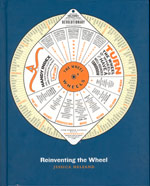Reinventing The Wheel | |

| I'm always intrigued by other people's obsessions. I'm always fascinated by the things that people collect, no matter what it is. I think it's partly because I can sympathise with the impulse to collect, even though I am too scatter-brained to do it properly myself. My collections of things always lose focus. I lose interest too quickly, can't sustain an obsession for too long, so I end up with only part-collections of things. I guess when it comes right down to it I'm just a dilettante. Jessica Helfland is no dilettante. Certainly not when it comes to information wheels. The proof is in her Reinventing The Wheel (Princeton Architectural Press. £17.95), a lavish 160 page tome that collects examples of this appealingly analogue information system ranging from circular mathematical slide rules to Captain Marvel phonetic decoders; from nuclear bomb blast calculators to gestational breeding planners; from astronomical planispheres to presidential trivia plotters. It all makes for a strange and strangely beguiling alternative trip through history. From the 14th to the 21st Centuries, the development of the information wheel charts cultural and social change, although naturally it's mainly with the media explosion of the 20th Century that the story really gets intriguing, as the wheel moves from being purely an informational product into an advertising device. As a result there's the likes of Kellog's 1932 wheels of Canadian and American Knowledge and Wonder Bread's range of wheels from WW2 that act as guides to planes and warships. Of course, as is the nature of collections, everyone will have their favourites. Personally I'm taken with the 1973 'Puzzle Pets Letter Wheels' by Holt, Reinhart and Winston of New York. The cat and fox are particularly appealing. I also like the 1967 'Country Music Staroscope Wheel' for it's wacky typography mixture, whilst Holgate Toys' 1952 'Toy Selector' has gorgeous graphics that remind me of the sleeve of the Laugh album. On a more surreal note, the US Army Intelligence 1975 issue of the 'Soviet Weapons Whiz Wheel' is a strange constructovist style design and will tell you such details as the rate of fire of an AK47 rifle. Essential stuff. In these days of instant digital information retrieval, the analogue information wheel can often look like a quaint artefact; a basic device from simpler times. On closer inspection however, it's not really the case. As proven by the illustration showing the interior disc of the 1932 'Story Of Our Presidents' disc, these discs were often complex devices that provided a wide range of information quickly and clearly. As Helfand (herself a designer) makes evident, many contemporary interface designers in the digital age would do well to look at the elegant solutions offered by the information wheel as a basis for modern interactive systems. |

| Not quite a book of a collection, but similarly using products as a means of tangentially charting cultural history, is David Attwood's Sound Design (Mitchell Beazley, £20). Packed with photographs charting the development of audio and hi-fi product design from the 1940s to the present day, Sound Design casts a pretty wide net. It attempts to present the designs within a historical and cultural context, but really it's too abbreviated and the cultural angle doesn't work too well. The slight spreads that pepper the book with titles like 'Solid State and Super Groups' or 'Disco and Punk' seem arbitrary and out of focus and really don't break the book down into sensible eras in the way that they hope to. The 'Solid State' section for example has a photo of Hawkwind for goodness sake, whilst the 'Disco and Punk' spread seems to forget the punk bit (is the picture of The Cars picture disc meant to be 'punk'?) and focuses on Disco, with a big picture of Donna Summer and a smaller shot of a roller-disco. Bizarre. If the cultural commentary angle is a damp squib, at least there are great photos of hi-fi equipment, and Attwood is clearly more at home with the technicalities of the equipment than the cultural meaning of the music that gets played on it. There's a mix of shiny hi-fi that looks like it belongs on a space station, through to cheap and cheerful stuff like portable transistors. For me, it's this material that really appeals, and it's great looking at pictures of old Dansettes and transistor radios, thinking how great this book would be as a resource if I was still making the kind of fanzines that appeared in the '80s, full of pictures of devoutly analogue technology. The contemporary equipment just doesn't quite have the same romantic quality to it, which might be a question of scale and lack of moving parts, or might be a question of less creative designers, but is certainly a question for another time. Sound Design is a diverting enough book, and will no doubt find favour with the idle music enthusiast, although I expect true hi-fi buffs will shun it as being too lo-brow. Similarly, hipster design students may find it a bit staid, with the lack of real cultural commentary a drawback. They'll also no doubt bemoan the fact that there's no place given to the iconic Vinyl Killer (the VW van you stick on your records - it rides around the grooves playing the record through it's roof!), and will probably point to the ace giant turntable poster that came with issue 4 of Grand Royal as the only visual reference for turntable design you need. And they'd probably be right. © Alistair Fitchett 2002 |